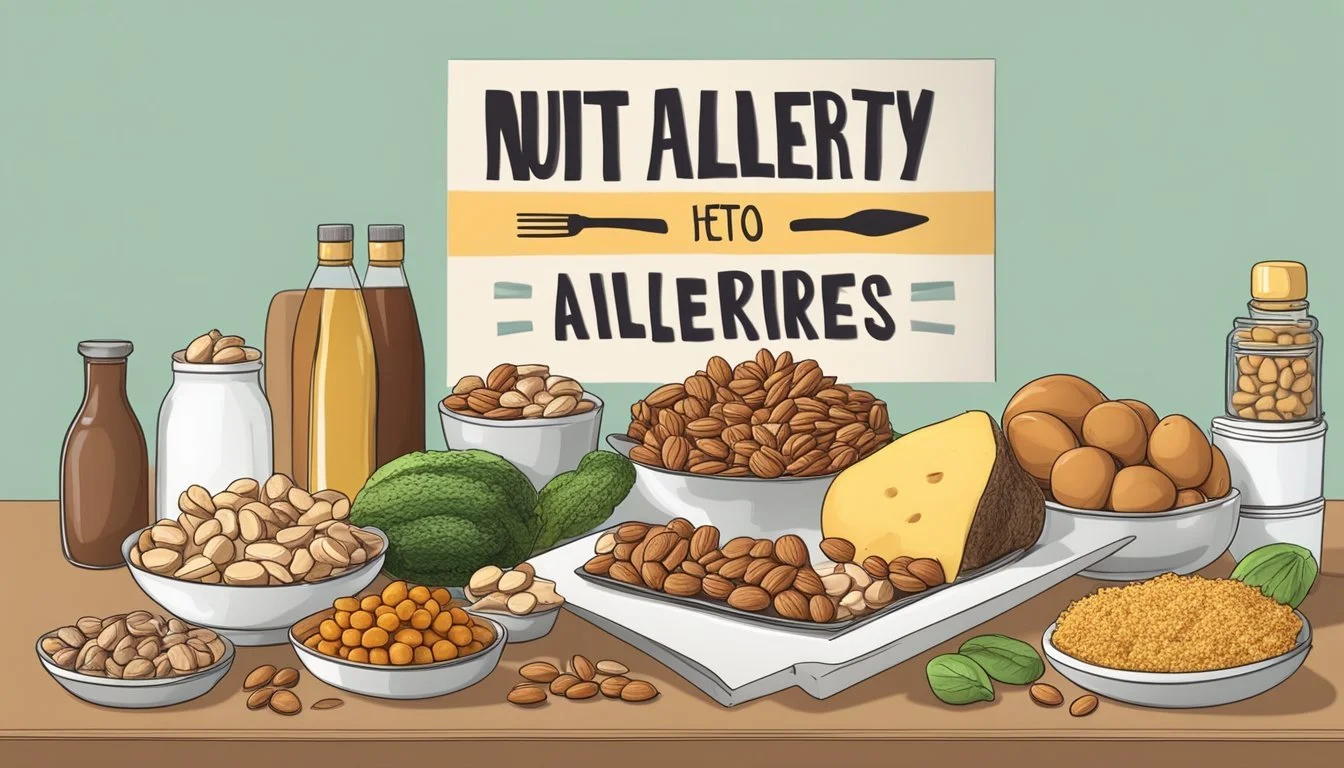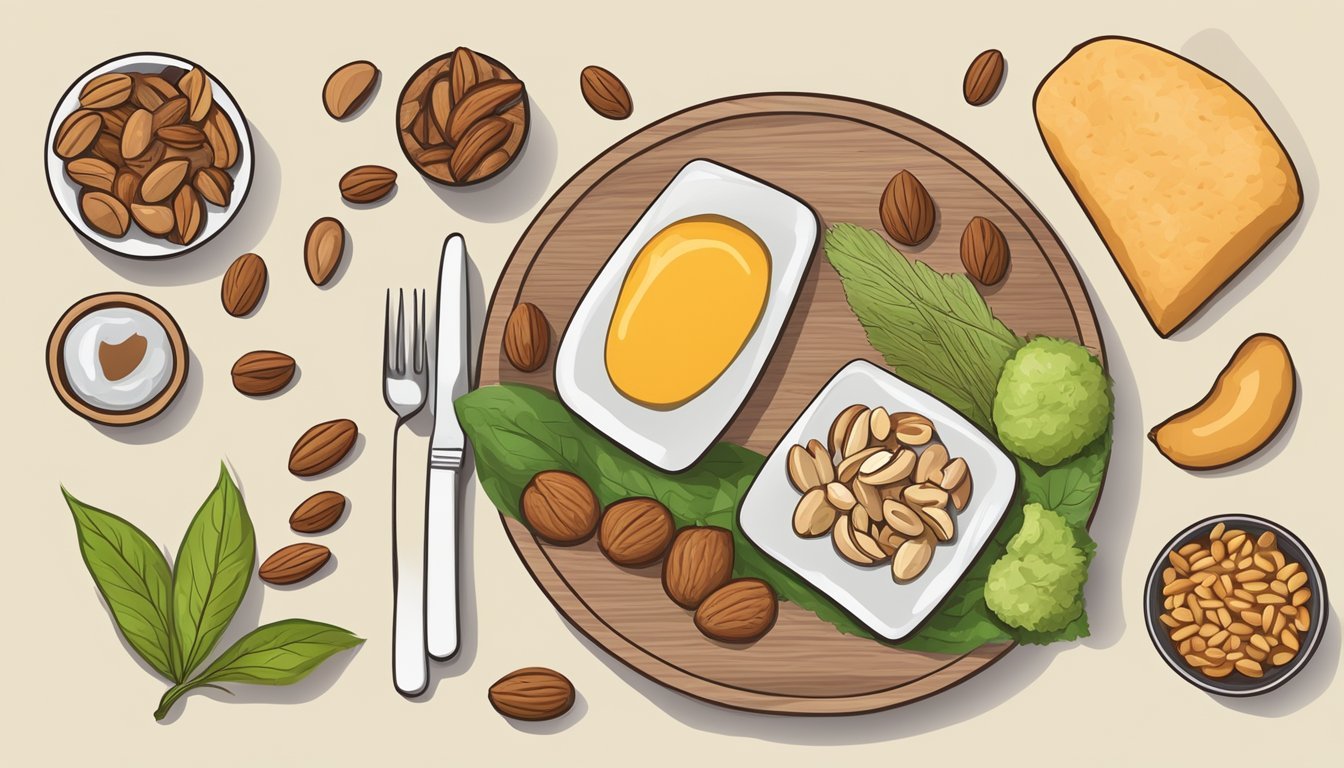Keto Diet and Nut Allergies
Managing Health with Dietary Restrictions
The ketogenic, or keto, diet is a high-fat, low-carbohydrate eating plan that has gained popularity for its potential benefits in weight loss, blood sugar control, and improved cognitive function. However, for individuals with nut allergies, this diet can present challenges, as nuts and nut products are commonly used as key sources of healthy fats and protein in keto-friendly recipes. Adapting the keto diet to exclude nuts requires careful consideration and planning to ensure nutritional needs are met while avoiding allergens.
People with nut allergies embarking on a keto diet need alternatives that maintain the diet's macronutrient ratio without compromising their safety. Typically, nuts provide essential fatty acids, protein, and texture in keto recipes. Those with nut allergies must find substitutes, such as seeds, dairy, if not lactose intolerant, or nut-free flours like coconut or sunflower seed flour. Planning and selecting ingredients carefully is crucial to successfully follow a keto diet without triggering an allergic reaction.
The market now offers various resources and recipes catered to nut-free keto diets, helping individuals navigate their dietary restrictions. The growing availability of such targeted information empowers people with nut allergies to explore the keto diet's benefits without risk, highlighting the importance of inclusive dietary resources. With prudent meal planning and an awareness of nut-free alternatives, individuals with nut allergies can safely adopt and maintain a ketogenic lifestyle.
Understanding the Keto Diet
The ketogenic diet centers around high-fat, low-carbohydrate eating as a means to induce the body to enter a state of ketosis.
Fundamentals of a Ketogenic Lifestyle
The ketogenic, or "keto," diet is a high-fat, adequate-protein, and low-carbohydrate diet. The primary goal of this diet is to shift the body's metabolism away from carbohydrates and towards fats and ketones. When carbohydrate intake is significantly reduced, the body enters a metabolic state known as ketosis, where it efficiently burns fat for energy instead of glucose. This state can contribute to weight loss and may provide an energy boost.
Key components of a ketogenic lifestyle include:
High-fat foods: Avocado, cheese, butter, and oils are staples.
Adequate-protein sources: This includes meat, fish, and eggs.
Minimal carbohydrates: Green leafy vegetables, above-ground vegetables, and other low-carb options.
Ketogenic diets vary in their approach, but they generally limit the daily carb limit to about 20-50 grams to sustain ketosis.
Managing Macronutrients and Net Carbs on Keto
Understanding and managing macronutrients is crucial on a ketogenic diet. Macronutrients are divided into three categories:
Fats: Should constitute the majority of caloric intake, typically 70-80%.
Proteins: Moderate intake, usually making up about 20-25% of calories.
Carbohydrates: Significantly limited, often comprising 5-10% of caloric intake.
The concept of net carbs is essential in a ketogenic diet. Net carbs are calculated by subtracting the grams of fiber and certain sugar alcohols from the total carbs in a food item. This provides a more accurate representation of carbohydrates that affect blood sugar levels. Staying within the net carb count is important for maintaining ketosis. Adherents of the diet aim to keep their net carb count below their daily carb limit to sustain the state of ketosis that makes the diet effective for their goals.
Nut Allergies Defined
Nut allergies are among the most common food allergies, potentially causing severe and even life-threatening reactions. They involve the immune system's abnormal response to proteins found in certain types of nuts.
Distinguishing Types of Nut Allergies
An individual with nut allergies may react to tree nuts, such as almonds, walnuts, and cashews, or he or she may be allergic to peanuts, which are actually legumes. It's important to differentiate because someone might be allergic to peanuts but not to tree nuts, or vice versa.
Tree nut allergy: A hypersensitivity to the proteins found in tree nuts.
Peanut allergy: A separate kind of allergy involving a reaction to peanuts, which are not true nuts.
Recognizing Allergic Reactions and Sensitivity
The symptoms of a nut allergy can range from mild to severe and might include hives, itching, swelling, and gastrointestinal issues. In extreme cases, an allergic reaction can cause anaphylaxis, a life-threatening condition that requires immediate medical attention.
Key indications of a nut allergy typically manifest as:
Skin reactions, such as hives, itching, or eczema
Swelling of the lips, face, and throat
Respiratory problems
Immune System and Nut Allergies
Nut allergies occur when the immune system mistakenly identifies the proteins in nuts as harmful and mounts an attack. This immune response can trigger a range of symptoms that constitute an allergic reaction.
The body's key players in an allergic response to nuts:
IgE antibodies: These attach to allergens and signal the immune system to release chemicals.
Histamines: Chemicals released by the body during an allergic reaction, causing the symptoms of allergies.
Navigating Keto with Nut Allergies
For individuals with nut allergies, adhering to a ketogenic diet requires careful selection of ingredients and recipes. Successful navigation of a nut-free keto diet centers on recognizing safe substitutes and meticulously checking for hidden nuts.
Safe Substitutions and Alternatives
Ingredients Nut-Free Keto Alternatives Almond flour Coconut flour, seed flours (such as sunflower or pumpkin) Peanut butter Seed butters (e.g., sunflower, tahini), soy nut butter Mixed nuts Roasted seeds (pumpkin, sunflower), soy nuts Eggs Often used without issues; however, options include flax or chia eggs for those with egg allergies
When embarking on a keto diet without nuts, it's vital to acknowledge that not all substitutes will work identically in recipes. Coconut flour, for example, is highly absorbent and may require additional liquid. Seed butters like tahini can replace almond butter, but they might have a more prominent flavor. When selecting these alternatives, individuals should ensure they are genuinely nut-free as cross-contamination could occur during manufacturing.
Identifying Hidden Nuts in Ingredients and Recipes
Nut allergens can inadvertently slip into recipes via less obvious ingredients. Critical examination of food labels is necessary as nuts can appear in the form of oils, flours, and even within spice blends. Additionally, "natural flavors" or "spices" listed on packaging can sometimes contain nut derivatives, so reaching out to manufacturers for clarification may be required.
Common Culprits to Scrutinize:
Processed foods: Can contain nuts as fillers or flavor enhancers
Dressings and sauces: May utilize nut-based oils or pastes
Dairy alternatives: Especially those that are marketed as keto-friendly might utilize almond or cashew milk bases
For accurate identification, individuals should familiarize themselves with the various names that nuts might be listed under, particularly scientific or alternative names, and should always opt for whole, unprocessed foods when available to minimize risk. Many nut-free recipes are available which specifically cater to keto dieters, ensuring that they can enjoy varied and flavorful meals without the concern of nut exposure.
Keto-Friendly Nut-Free Recipes
For individuals with nut allergies, following a keto diet doesn’t mean missing out on delicious foods. This section offers a selection of keto-friendly, nut-free recipes that cater to various meals throughout the day, ensuring you get your taste of sweetness, flavor, and nutrition without the nuts.
Breakfast Options Without Nuts
Nut allergies require breakfast options that are both nourishing and keto-compliant. Cottage Cheese (how long does cottage cheese last?) Breakfast Muffins are an excellent start, packed with protein and void of nuts. They're easy to prepare and can be made with coconut flour instead of nut flours. For a savory option, a Hash Brown Breakfast Casserole utilizing cauliflower instead of potatoes keeps carbs low and provides a source of vitamins and minerals.
Desserts and Sweets for Keto Dieters with Nut Allergies
Those following a keto diet with a sweet tooth can indulge in Chocolate Chip Cookies made with keto-friendly sweeteners and sunflower seed flour as a nut-free alternative. For a quick treat, Pumpkin Pie Mug Cakes use a blend of keto-friendly baking powder and spices. Moreover, Chocolate Bar Fat Bombs provide antioxidants and satisfy chocolate cravings without compromising on keto guidelines or nut content.
Main Meals and Side Dishes
Main meals are effortlessly adaptable to nut-free keto diets. Seafood dishes (What wine goes well with seafood dishes?) like Bacon-Wrapped Water Chestnuts offer a rich source of protein and omega-3 fatty acids, essential for any diet, and especially important for those on keto. For side dishes, Stuffed Bell Pepper Casserole is both substantial and flavorful, providing vitamins without the need for nuts. The use of a crockpot can simplify the preparation of main courses, like a chicken mushroom casserole, ensuring dishes are both easy to make and aligned with nutritional needs.
The Role of Dairy, Eggs, and Seeds in a Nut-Free Keto Diet
When following a nut-free keto diet, understanding the importance of dairy, eggs, and seeds helps in maintaining a balanced nutritional intake. These ingredients can replace nuts as sources of essential fats, proteins, and other nutrients.
Incorporating Dairy Wisely
Dairy products, such as cheese and yogurt, can be included in a nut-free keto diet to provide calcium, protein, and fat content. It's crucial for individuals to choose full-fat versions to align with the keto macronutrient distribution. However, one should be mindful if they are sensitive to dairy proteins or lactose intolerant. In such cases, lactose-free options or dairy alternatives may be used.
Examples of dairy for a nut-free keto diet:
Cheese: Full-fat, hard cheeses are typically lower in lactose.
Yogurt: Opt for unsweetened, full-fat Greek yogurt.
Using Eggs as a Nutrient-Dense Staple
Eggs are a cornerstone in a nut-free keto diet, providing high-quality protein and fats without the need for nuts. They are incredibly versatile and can be prepared in various ways, making them a staple for meals. Eggs also contain essential vitamins and minerals which support overall health.
Nutritional Profile of Eggs:
Protein: ~6 grams per egg
Fat: ~5 grams per egg
Carbs: <1 gram per egg
Seeds: A Versatile Alternative
Seeds, such as chia seeds, sunflower seeds, and shredded coconut, present a valuable nut alternative for those on a keto diet with nut allergies. They offer fiber, healthy fats, and are rich in nutrients while fitting within the keto framework. Sunflower seed butter can be used as a spread in place of nut butters, and chia seeds make for a great addition to smoothies and keto-friendly porridges.
Seed Options & Benefits:
Chia Seeds: High in fiber and omega-3 fatty acids.
Sunflower Seeds: Can be ground into flour or used to make sunflower seed butter.
Shredded Coconut: Can be used for texture in baking and cooking; coconut oil is also a healthy fat option on keto.
Managing Food Allergies Beyond Nuts on Keto
When adopting a ketogenic diet, individuals with food allergies must be vigilant. This section examines key considerations for those dealing with allergies to foods other than nuts.
Considering Common Allergens: Seafood, Shellfish, and More
Seafood and Shellfish Allergies: These are common and can be severe, with symptoms ranging from mild discomfort to anaphylaxis, a potentially life-threatening reaction. Individuals must scrutinize ingredients as fish and shellfish (What wine goes well with shellfish?) can be hidden in sauces or broths.
Eggs and Dairy Sensitivities: Though prevalent in keto-friendly foods, people with sensitivities to these must find alternatives. Dairy can often be replaced with lactose-free options or plant-based substitutes.
Soy Allergies: Often used in low-carb products, soy can be an allergen lurking in keto meals. Reading labels carefully to avoid soy is crucial for those with this allergy.
Immune System Responses: Allergies involve an abnormal immune system response to certain foods. While on keto, ingesting an allergen can cause the immune system to overreact, leading to a variety of symptoms. It is important for people to recognize and respond to these signs promptly.
Proper management of food allergies extends beyond avoiding nuts on a keto diet. It includes diligently checking for and avoiding all allergens that could trigger an immune response.
Nutritional Considerations and Health Outcomes
The ketogenic diet with a focus on nut allergies prioritizes safe alternatives to ensure adequate nutrient intake while aiming to achieve weight management and metabolic benefits, maintain micro and macronutrient balance, and support heart health and blood pressure.
Weight Management and Metabolic Benefits
The ketogenic diet, high in fats and low in carbohydrates, triggers the body to enter a state of ketosis, wherein it burns fat for energy, potentially resulting in weight loss. Individuals often report increased energy levels due to the steady supply of ketones as fuel. For those with nut allergies, seeds and seed-based butters can serve as alternative fat sources that are rich in beneficial nutrients and conducive to weight management goals.
Micro and Macronutrient Balance
Achieving nutritional balance on the ketogenic diet without nuts involves a careful selection of foods that provide essential vitamins, minerals, and antioxidants. Seed-based foods, leafy greens, and certain fish are excellent sources of Vitamin E and selenium, vital antioxidants supporting cellular health. Dairy-free and nut-free keto options can help maintain the balance of macronutrients.
Vitamins: Leafy greens and avocados for Vitamin K and folate.
Minerals: Shellfish and seeds for zinc and magnesium.
Antioxidants: Berries and cocoa, in moderation, for flavonoids.
Heart Health and Blood Pressure
The focus on high-fat intake within the keto diet raises questions about heart health. Yet, by choosing fats wisely, one can enrich their diet with omega-3 fatty acids known for their heart-protective effects. Foods such as fatty fish (like salmon, sardines), flaxseeds, and chia seeds can be excellent additions. Furthermore, the low carbohydrate content can lead to lower blood pressure readings, since keto diets may reduce insulin levels and excess water retention, promoting better cardiovascular health.
Heart-Healthy Fats: Fatty fish, olive oil, and avocados.
Blood Pressure: Reduction in processed foods may naturally lower sodium intake, aiding blood pressure control.
Shopping and Preparing Nut-Free Keto Meals
When shopping and preparing meals for a nut-free keto diet, individuals must pay close attention to food labels and be mindful of potential cross-contamination to maintain both a ketogenic and allergen-free kitchen.
Reading Labels and Avoiding Cross-Contamination
Reading Labels: Individuals should carefully read product labels every time they shop. Manufacturers can change ingredients and production methods, so it's important to look for any mention of nuts and phrases like "may contain nuts" or "produced in a facility that also processes nuts." Ingredients that are keto-friendly and nutrient-dense include seeds (like sunflower or pumpkin), healthy fats (like avocado oil or olive oil), and various proteins (including meat and dairy).
Avoiding Cross-Contamination: To prevent cross-contamination, shoppers should choose products certified as nut-free. In the kitchen, they need to use separate utensils and surfaces for nut-free keto meal preparation. Tools and appliances should be thoroughly cleaned if they have been in contact with nuts. For those with severe allergies, it is also wise to buy whole foods that are less processed to minimize risks.
Individuals can find a variety of nut-free keto recipes which commonly incorporate ingredients such as coconut flour, chia seeds, and stable fats like butter or ghee. Successful meal prep involves sourcing quality, keto-compliant and nut-free ingredients and ensuring that the kitchen environment is safe for those with nut allergies. The meal preparation process should focus on cleanliness and attention to detail to adhere to keto guidelines while preventing allergen exposure.
Lifestyle Tips for Success on Keto with Nut Allergies
Adhering to a ketogenic diet when managing nut allergies can be challenging, yet achievable with careful planning. Individuals on a keto diet aim to enter a state of ketosis, where the body burns fat for fuel. This often involves the consumption of high-fat foods, which commonly include nuts. However, nut allergies require alternative sources of fats and protein to prevent adverse reactions such as bloating, gas, or more severe allergic responses.
Safe Fat Sources: When replacing nuts, one should incorporate other high-fat, low-carbohydrate foods. Options include:
Avocado
Seeds (pumpkin, sunflower, hemp)
Olives and olive oil
Coconut products (ensure no allergy to coconut as it is a fruit)
A balance of protein is vital on keto to prevent muscle loss and to manage weight gain. People with nut allergies can opt for:
Grass-fed meats
Fatty fish (salmon, mackerel)
Eggs
Full-fat dairy (for those not lactose intolerant)
Individuals who may have collagen or gelatin allergies need to be mindful of keto-friendly supplements or protein sources that could contain these allergens.
Meal Preparation: One should carefully read labels and prepare meals at home to ensure no cross-contamination with nuts.
Use nut-free keto recipes and perform necessary modifications
Consider meal planning to avoid last-minute choices that might not be allergy-safe
Implementing these strategies can help one maintain a keto lifestyle without compromising their health due to nut allergies. Regularly consulting with a nutritionist can further tailor the diet to individual needs, ensuring nutrient requirements are met and allergies are managed successfully.
Conclusion and Future Considerations
The interplay between dietary choices, such as the ketogenic diet, and nut allergies is a complex and evolving subject. As individuals with nut allergies venture into ketogenic eating plans, careful consideration of ingredient selection is paramount to ensure safety and to avoid allergenic reactions. There is a growing body of evidence that supports the ketogenic diet's efficacy in weight loss; however, the impact on those with food allergies, particularly nut allergies, requires further research.
Adaptations for those with nut allergies on a keto diet could involve the substitution of nuts with seeds or other fat-rich, low-carbohydrate foods. It is recommended that individuals consult healthcare providers to tailor a plan that meets nutritional needs while accommodating allergy restrictions.
Future research should aim to:
Refine alternative keto-friendly food lists for individuals with nut allergies, emphasizing nutrient density and safety.
Explore the long-term effects of the ketogenic diet on individuals with food allergies, which remains relatively uncharted.
Assess the quality of life for individuals with nut allergies who follow a ketogenic diet to understand the diet's broader implications beyond weight management.
As management strategies for nut allergies advance, integration with dietary plans like keto will likely improve. Continuous updates and education for both healthcare providers and individuals with allergies are critical for sustained dietary success and overall health.








